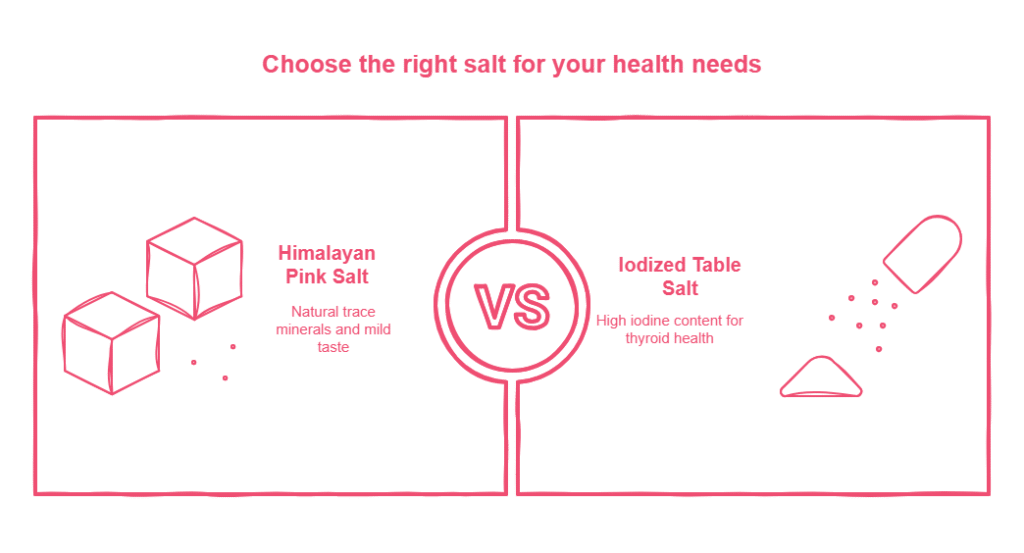
Himalayan pink salt has taken the culinary and health world by storm. It stands out from common table salt in that it is a beautiful pink color, has mineral content, and carries a reputation as “healthier salt.” However, the question on many people’s minds is, does Himalayan pink salt contain iodine?
If you want to make sure it does all the above for thyroid health, energy, your metabolism or if you care about preventing iodine deficiency then this is an important question.
We discuss it below in plain English. If Himalayan salt is iodized at all, have a concerning amount of iodine to start with, and how this affects your health.
Read More: Health Benefits Of Himalayan Pink Salt
Table of Contents
Why Iodine Matters for Your Health
Iodine is a trace mineral your body needs only a small amount, but it plays a big role in keeping you healthy.
Your thyroid gland uses iodine to make thyroid hormones (T3 and T4). These hormones control:
- Metabolism — how your body burns calories
- Growth and development — especially important for children
- Energy levels — how active and alert you feel
- Brain function — supports focus and mood
Without enough iodine, your thyroid can’t work properly. This may lead to:
- Goiter — a swelling in the neck from an enlarged thyroid
- Hypothyroidism — low thyroid activity, which can cause tiredness, weight gain, and depression
- Development problems in children — if mothers don’t get enough iodine during pregnancy

Daily Iodine Requirement:
- Adults: 150 micrograms (mcg)
- Pregnant women: 220 mcg
- Breastfeeding women: 290 mcg
What is Himalayan Pink Salt?
Himalayan pink salt is a type of rock salt that comes from the Khewra Salt Mine in Pakistan, one of the oldest and largest salt mines in the world.
It gets its pink color from trace minerals such as:
- Iron — gives it the pinkish-orange tint
- Potassium — supports heart and muscle function
- Magnesium — helps with muscle relaxation and nerve health
- Calcium — good for bones and teeth
These minerals make up only about 2–4% of the salt, while the rest is still sodium chloride (just like table salt).
Does Himalayan Pink Salt Contain Iodine?
The short answer: Yes, but very little.
Himalayan pink salt naturally contains trace amounts of iodine, but not nearly enough to meet your daily needs.
On average, it contains less than 0.1 mg (100 mcg) of iodine per kilogram of salt far lower than what your thyroid needs daily.
For example:
- 1 gram of Himalayan salt = roughly 0.1 mcg iodine
- Daily need for an adult = 150 mcg iodine
That means you’d have to eat over 1.5 kilograms of pink salt a day to meet your iodine requirement which is impossible and unsafe because of the sodium overload.
Himalayan Pink Salt vs. Iodized Salt
Most regular table salt is iodized, meaning iodine is added to prevent iodine deficiency in the population. This public health measure began in the 1920s and helped reduce goiter cases worldwide.
Here’s a quick comparison:
Feature | Himalayan Pink Salt | Iodized Table Salt |
Iodine content | Very low (natural trace) | High (added iodine) |
Processing | Minimal, unrefined | Refined, iodine and anti-caking agents added |
Taste | Mild, slightly earthy | Strong, plain salty taste |
Color | Pink to dark rose | White |
Health focus | Trace minerals, natural appeal | Thyroid health via iodine |
Conclusion: If iodine intake is your priority, iodized salt is the better choice.
Benefits of Himalayan Pink Salt
Even though it’s not an iodine powerhouse, Himalayan pink salt has some attractive features:
- Contains over 84 trace minerals (in tiny amounts)
- Less processed compared to refined table salt
- Attractive appearance — makes food look gourmet
- Mild flavor — enhances dishes without overpowering them
- Used in spa treatments and salt lamps for relaxation (though scientific proof is limited)
Read about: Himalayan Spa Body Roller
Drawbacks of Himalayan Pink Salt
- Very low iodine content — not enough for thyroid needs
- More expensive than regular salt
- Overhyped health claims — it’s still mostly sodium chloride
- No significant evidence it’s better than regular salt for blood pressure or hydration
If You Use Pink Salt, How to Get Enough Iodine
You can enjoy Himalayan pink salt and still avoid iodine deficiency by eating iodine-rich foods, such as:
- Seaweed — kelp, nori, wakame (very high in iodine)
- Fish — cod, tuna, sardines, shrimp
- Dairy — milk, yogurt, cheese
- Eggs — especially the yolk
- Iodized salt — you can mix small amounts with pink salt for balance
Tip: You don’t have to give up Himalayan pink salt just make sure your diet includes other iodine sources.
Common Myths About Himalayan Salt and Iodine
- “Pink salt has enough iodine to replace iodized salt” — False. The iodine level is too low.
- “Natural iodine is better than added iodine” — Not true. Your body uses both forms the same way.
- “Himalayan salt prevents thyroid problems” — No, it doesn’t directly prevent them unless paired with iodine-rich foods.
How to Choose the Right Salt for Your Needs
- For thyroid health → Include iodized salt or iodine-rich foods.
- For flavor and presentation → Use Himalayan pink salt.
- Best approach → Use both types of salt in moderation.
Remember: The World Health Organization (WHO) recommends less than 5 grams (about 1 teaspoon) of salt per day to avoid high blood pressure and heart disease no matter which type you use.
Final Takeaway
Does Himalayan pink salt have iodine?
Yes, but only in tiny, natural trace amounts not enough for your daily needs.
While it’s beautiful, natural, and tasty, it’s not a reliable source of iodine for thyroid health.
If you love Himalayan pink salt, enjoy it in your meals, but balance your diet with iodine-rich foods or a small amount of iodized salt. This way, you get the best of both worlds flavor, minerals, and essential thyroid support.
Choosing authentic Himalayan salt, like the one offered by Sobaan Salts, ensures you are getting an unprocessed product straight from nature.
Himalayan pink salt contains <0.1 mcg iodine per gram—far below the 150 mcg daily requirement for adults. In contrast, iodized salt provides 71 mcg per ¼ teaspoon (47% DV). (Sources: NIH, USDA)
References:
World Health Organization (WHO) – Salt Reduction
https://www.who.int/news-room/fact-sheets/detail/salt-reduction
National Institutes of Health (NIH) – Iodine Fact Sheet
https://ods.od.nih.gov/factsheets/Iodine-HealthProfessional/
Harvard T.H. Chan School of Public Health – The Nutrition Source (Salt & Sodium)
https://www.hsph.harvard.edu/nutritionsource/salt-and-sodium/
Share This Post
Article By

